

This brief is based on NBP Working Paper no. 373 entitled “Immigration (from Ukraine) and labour market in Poland – evidence from Bayesian VAR models”. The views expressed in this brief are those of the authors and do not necessarily reflect the views of Narodowy Bank Polski.
Abstract
This policy brief analyses the impact of immigration shocks on the labour market in Poland – a country that experienced a significant inflow of immigrants (including refugees) after Russia invaded Ukraine in 2014 and 2022. Our results, based on structural BVAR models, suggest that the impact of the 2022 refugee wave on the Polish economy differs from previous immigration inflows, primarily influencing aggregate demand and, to a lesser extent, boosting labour supply. In recent years, immigration shocks have slightly reduced the unemployment rate and, to a greater extent, lowered the annual growth rate of real wages. They also contributed to higher growth in nominal wages, particularly after 2022, when the inflow of non-working immigrants, which created significant consumption demand, was at its highest.
For a very long time, the Polish population emigrated willingly and frequently. This was particularly evident after accession to the European Union (EU) in 2004, when thousands of Poles decided to leave their home country and look for work in wealthier old EU member states. As reported by Strzelecki et al. (2022), between 2002 and 2013 approximately 1.2 million Polish citizens (about 3% of the population) emigrated, and the most substantial and rapid wave occurred between 2004 and 2008, with around 0.7 million emigrants heading to the UK and Ireland.
The situation completely changed in 2014, when the outbreak of the armed conflict in Eastern Ukraine and the subsequent economic crisis in the country triggered a large and rapid surge in the number of Ukrainians migrating to the EU, and Poland in particular. In the years 2014-2018, Poland admitted probably between one and two million immigrants from Ukraine (Strzelecki et al., 2022). The scale of this inflow was unprecedented in Poland’s history and raised many questions, especially in the context of labour market outcomes, as well as long-term growth prospects. According to the estimates by Statistics Poland (GUS, 2020) based on administrative registers and information provided by the Border Guard, at the end of 2019, Ukrainians were by far the most numerous group of foreigners in Poland, with their number exceeding 1.35 million.
A full-scale Russian aggression against Ukraine in 2022 entailed another spike in the number of Ukrainians leaving the country. The resulting refugee crisis, estimated by UNHCR as of February 2025 at 6.8 million persons1, was the largest displacement in Europe since World War II. According to the Polish Border Guard data, the number of crossings of the Ukrainian-Polish border by foreign citizens in the first two months of the conflict amounted to almost 3.5 million. Although many refugees stayed in Poland only temporarily and later moved to other European countries, Poland still shelters a relatively large number of Ukrainians fleeing the war. As of June 2023, it was the second (after Germany) largest host country for refugees from Ukraine, sheltering almost 1 million Ukrainian escapees (OECD, 2023).
The Russian invasion changed not only the size but also the structure of immigration from Ukraine. The group of previous immigrants was dominated by men and economically active persons (Kaczmarczyk, 2022), which, given the relatively strong demand for workers in Poland at that time, provided great support to the Polish labour market, alleviating labour shortages and mitigating wage pressures. On the other hand, Ukrainian refugees are mainly women, children and elderly persons, characterised by, on average, lower activity rates2. Consequently, the impact of the latest refugee wave on the Polish economy may be different from previous immigrant inflows, affecting the aggregate demand and, to a lesser extent, boosting the labour supply. In our study, we aim to shed more light on both these channels and add to the debate on the macroeconomic impacts of immigration shocks.
To evaluate the importance of immigration shocks in shaping unemployment and wage fluctuations in Poland, we estimate the four-variable BVAR model proposed by Foroni et al. (2018) extended with newly constructed working and non-working immigration proxies. The series are based on Border Guard statistics and data from the Polish Social Insurance Institution (Figures 1 and 2), and they capture the variance over time rather than the exact number of immigrants. We find our results robust if alternative measures of immigration are used instead.
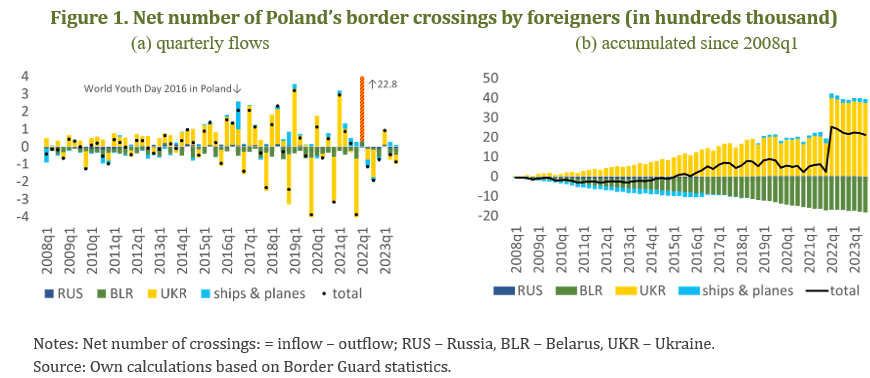
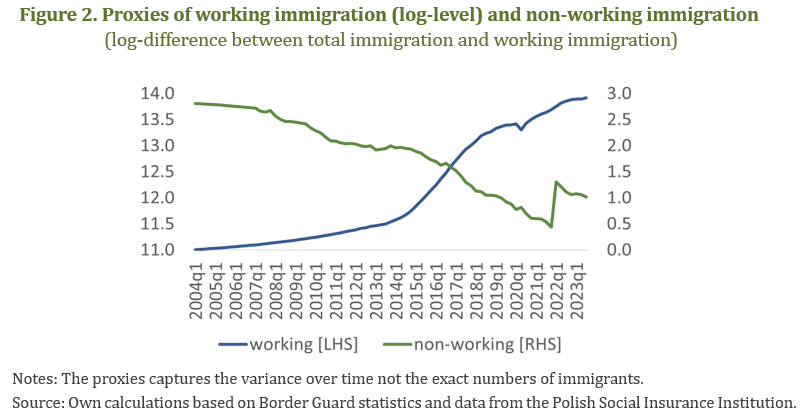
As depicted in Figure 3, positive working immigration shock raises the number of non-working immigrants (e.g. because a whole family may immigrate following a working head of the family), increases output, prices, and the unemployment rate, and lowers the real wages. The response of the latter two variables might be justified by the intensified job competition among the unemployed natives and immigrants. Similarly to the working immigration disturbance, the non-working immigration shock boosts output and prices, but its impact is virtually absent in the case of wages and negative in the case of unemployment rate (since immigrants expand consumer demand for goods and services and hence may enhance the creation of additional jobs).
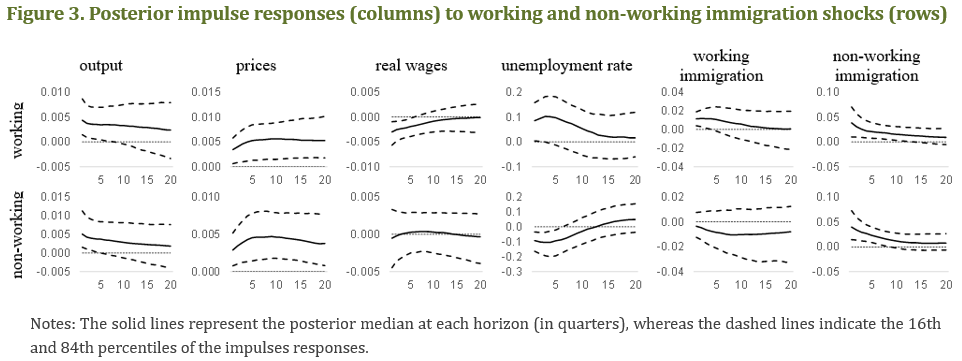
Historical decompositions based on the estimated BVAR model reveal that the recent immigration waves following the full-scale Russian invasion of Ukraine mildly reduced the unemployment rate (Figure 4). The effect is negative because the model interprets the 2022 inflow of refugees as mainly a non-working immigration shock (i.e. driving unemployment down). Therefore, the net contribution of both immigration shocks to the unemployment rate at that time is negative. Importantly, the potential negative impact of any shocks on the unemployment rate in that period is limited since before the outburst of the full-scale war, the unemployment rate in Poland had already been at levels close to historical minimums.
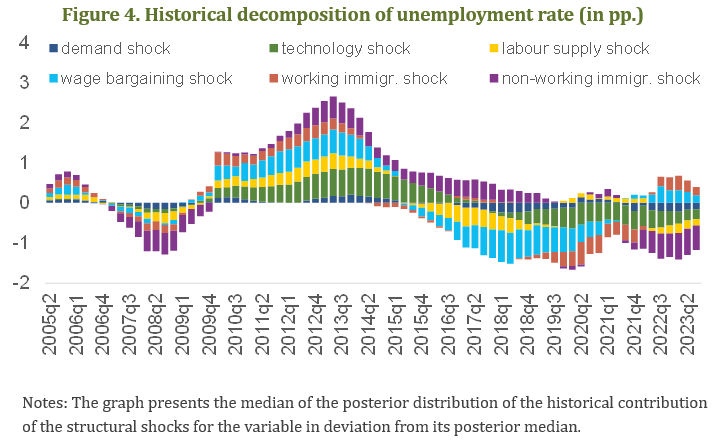
As suggested by the historical decomposition depicted in Figure 5, real wages are primarily driven by technology disturbances, followed by immigration, and in particular, working immigration shocks. The importance of immigration shocks was especially evident in 2022 and the first half of 2023, when they accounted for roughly half of the strong decline in real wages. In contrast to Foroni et al. (2018), our results suggest a relatively minor role for demand shocks in driving fluctuations in real wages.
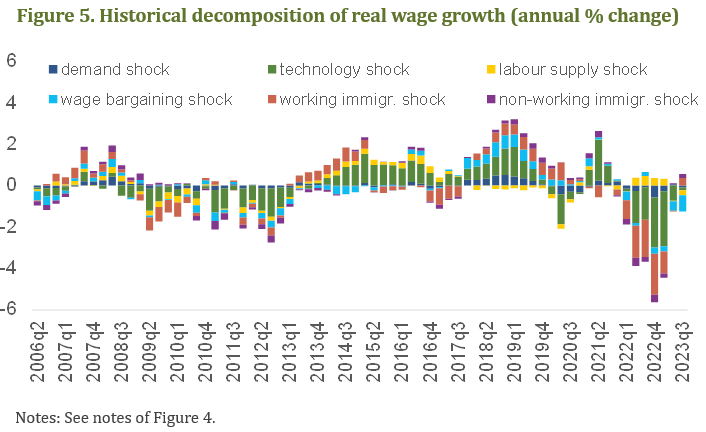
The importance of immigration shocks in driving fluctuations in nominal wages is even greater than in the case of real wages (Figure 6). Importantly, due to the inflationary nature of these disturbances3, their contributions to nominal wage dynamics tend to be opposite to those of real wages. Specifically, despite the strongly negative impact of immigration shocks on real wage growth in 2022, their contribution to nominal wage dynamics remained positive throughout the period (and into 2023).
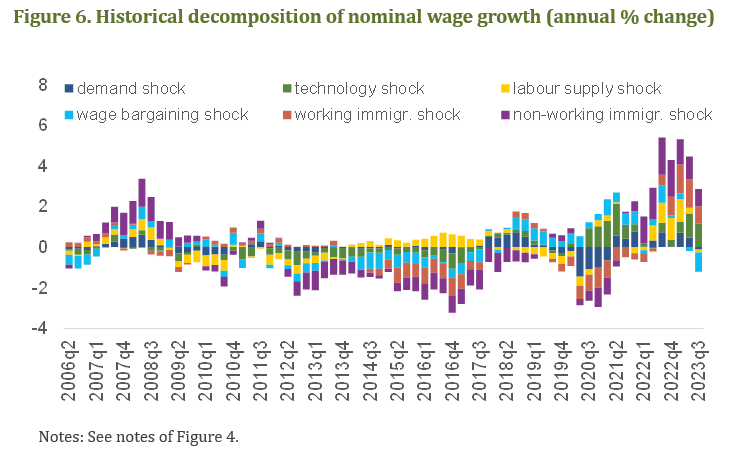
At this point, it is important to emphasize two things. First, the distinction between working and non-working immigrants seems to be crucial for conclusions regarding the role of immigration shocks in shaping unemployment fluctuations. This distinction allows for capturing the changing composition of immigrants and the different impacts of various types of immigration on the unemployment rate (recall that both types of immigration shocks affect the unemployment rate in opposite directions, as shown in Figure 3). A model in which all types of immigrants are combined does not fully capture the effects of the strong influx of refugees after 2022 and implies that the impact of the immigration shock on unemployment during this period is slightly positive, rather than negative, as is the case in the model with two immigration shocks.
Second, since the large and rapid inflow of immigrants in 2022 coincided with significant increases in energy prices and supply chain disruptions, and all three developments are generally inflationary, one might be concerned that the identified strong impact of immigration shocks on prices – and thus on nominal wages in recent periods – may not be solely due to immigration, but rather to two other factors that were highly correlated with immigration at the time. To address this concern, we extend our model to include shocks to energy prices and supply chain disruptions. Although accounting for these disturbances reduces the role of immigration shocks for all three considered labour market variables, and nominal wages in particular, immigration shocks remain a key driver of labour market fluctuations in Poland.
The ongoing migration flows from Ukraine, particularly following the 2022 Russian invasion, which triggered the largest refugee crisis in Europe since World War II, have significantly impacted labour markets in destination countries. In our study, we use the example of Poland – currently the second-largest host country for Ukrainian refugees – to evaluate the impact of these migration flows on unemployment, and real and nominal wages in this receiving country.
Our analysis confirms that immigration does matter for the dynamics of the labour market variables in Poland. In recent years, it has been mildly lowering the unemployment rate and, to a greater extent, the annual growth rate of real wages. On the other hand, the identified immigration shocks significantly contributed to higher nominal wage growth, particularly after 2022, due to the large and rapid influx of non-working immigrants, who created significant consumption demand, thereby exerting upward pressures on prices.
Foroni, C., Furlanetto, F., and Lepetit, A. (2018). Labor supply factors and economic fluctuations. International Economic Review, 59(3):1491–1510.
GUS (2020). Populacja cudzoziemców w Polsce w czasie COVID-19.
Kaczmarczyk, P. (2022). Ukrainian migrants in Poland during the war: the state of the art and key challenges. Social Insurance. Theory and Practice, 155(4):1–28.
NBP (2024). The living and economic situation of migrants from Ukraine in Poland in 2024. Survey Report.
OECD (2023). International Migration Outlook 2023. OECD Publishing.
Strzelecki, P., Growiec, J., and Wyszyński, R. (2022). The contribution of immigration from Ukraine to economic growth in Poland. Review of World Economics (Weltwirtschaftliches Archiv), 158(2):365–399.
source: https://www.unrefugees.org/emergencies/ukraine/ (last access: 21.02.2025).
Nevertheless, the participation rate among refugees from Ukraine is very high in Poland (NBP 2024).
Our results indicate a significant role of immigration shocks in shaping price fluctuations, and in particular, we identify them as one of the key drivers of elevated inflation in 2022–2023.